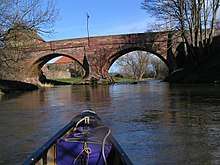East Linton Bridge
| East Linton Bridge | |
|---|---|
 | |
| Coordinates | 55°59′7″N 2°39′16″W / 55.98528°N 2.65444°W |
| Carries | A199 |
| Crosses | River Tyne |
| Locale | East Linton |
| Maintained by | East Lothian Council |
| Preceded by | East Coast Mainline Rail Bridge |
| Followed by | Tyneinghame Bridge |
| Characteristics | |
| Design | Masonry |
| Total length | 30 m (98.4 ft) |
| Width | 5.7 m (18.7 ft) |
| Height | 9.6 m (31.5 ft) |
East Linton Bridge, also called Old Tyne Bridge, is a bridge over the River Tyne in the village of East Linton in the county of East Lothian, Scotland. In 1971, the bridge was designated a category A listed building.[1]
History
Before the bridge was constructed, a ford approximately 100m upstream served as the crossing of the Tyne at East Linton. On the site of the current bridge was an earlier structure. On 7 September 1547, English infantry under the command of the Duke of Somerset crossed the Tyne on this bridge. Two years later in September 1549 the bridge was destroyed by French troops to delay the English retreat from the siege of Haddington. On 31 March 1560, Lord Grey, with an English force wrote from "Linton-Briggs", saying "we are now at Lintern (sic) Briggis etc".[2] Therefore the current bridge was probably built circa 1560 at the latest.[1]
Numerous repairs have been carried out carried out, including in 1625, 1639, 1661, 1763 and 1934. In the course of the work in 1763, the bridge was probably widened. The Edinburgh to Berwick-upon-Tweed post road, later to become the A1, crossed the Tyne on this bridge until 1927 when a new bypass and bridge were constructed upstream. The old A1 road is now re-classified as the A199.
Description
The 30m long and 5.7m wide masonry viaduct is located on the southern edge of the village. It spans the river with two segmental arches with spans of 12.2m. The masonry consists of roughly carved red and yellow sandstone, which was built into a layered masonry with bricked arches. The central pillar is equipped with a triangular protruding cutwater. The bridge has architectural parallels to the Abbey Bridge in Haddington. The delimiting balustrade was raised around 1895.[3]
References
- 1 2 "Bridge End, Old Bridge". portal.historicenvironment.scot.
- ↑ https://scotlandsplaces.gov.uk/digital-volumes/rcahms-archives/inventories/east-lothian-1924/187
- ↑ "East Linton, Old Tyne Bridge - Canmore". canmore.org.uk.